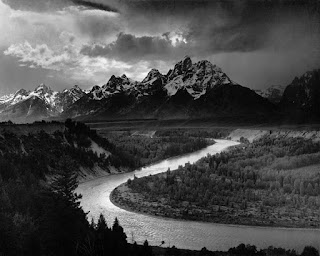Contextual Influences
Research Analysis
The Hand of Man was conventionally taken without
knowledge of shutter speeds. The composition of this shot is on the importance
of the machine in the modern industrial age. The angle of this image is taken
at eye level, this gives us the impression that if we were there at the time we
would see the train and its surroundings the same way that it was shot.
This images perspective is atmospheric because as you
can see in the photo that the buildings in the background look as if they are
fading away, this is probably due to the smoke around the train yard or the
weather at that current time.
Stieglitz used this type of perspective to show that a
gritty urban landscape can be turned in to an atmospheric beauty instead of the
usual unspoiled landscape that other photographers would usually use at the
time.
The image was taken in 1902 and published in the
inaugural issue of camera work in 1903. I think at the time the photo was taken
it definitely had an effect on the image because the method that it was
produced was photogravure which is when a negative is transferred to a metal
plate and is then etched in. This means that it would take a long time to
develop and that the quality of the image wouldn't turn out good.
The Tetons and the Snake River was conventionally
taken and as of the era didn’t know anything about shutter speeds. The
composition of this is focused on the landscape instead of just focusing on a
specific part in an image. The angle of this image is a mix between eye level
and a bird’s eye view this is because the photo is taken high up. The
perspective used in this image is Ariel/atmospheric because the mountains
contrast is changing the further the distance they are from the camera.
I think Ansel Adams used this perspective to show the
different contrasts between all of the scenery in the image. This image was
shot in 1942 and in 1942 there wasn’t little if any camera equipment and this
image were produced with the zone system which is a method for determining the
exposure and development for film photography.
 Mount Fuji was conventionally shot and had a slow
shutter speed even though most of the photos taken in the 50s were high shutter
speeds as they had just been discovered. The composition for this photo was the
mountains and everything surrounding them. The angle of this shot was at a low
level and the perspective of this shot was atmospheric due to the mountains
fading in the background.
Mount Fuji was conventionally shot and had a slow
shutter speed even though most of the photos taken in the 50s were high shutter
speeds as they had just been discovered. The composition for this photo was the
mountains and everything surrounding them. The angle of this shot was at a low
level and the perspective of this shot was atmospheric due to the mountains
fading in the background.I think that Koyo Okada wanted you to see how tall Mount Fuji actually was and he also managed to capture some of the river below. This image was created circa 1950s and I think the way the photo was developed definitely affects the image. Looking at the original image it doesn’t look black and white it actually looks like a sepia filter was added on to it.
 Untitled film still #48 was conventionally shot in 1979 and reprinted in 1998. This image conceived of a slow shutter speed. The composition of this photo is of a woman looking out at the scenery in front of her. Normally when having a subject in a shot you try to put all focus on them and not the person's surroundings, although this image captures both together beautifully. The angle of this shot is at eye-level as you can tell by looking at the model.
Untitled film still #48 was conventionally shot in 1979 and reprinted in 1998. This image conceived of a slow shutter speed. The composition of this photo is of a woman looking out at the scenery in front of her. Normally when having a subject in a shot you try to put all focus on them and not the person's surroundings, although this image captures both together beautifully. The angle of this shot is at eye-level as you can tell by looking at the model.The perspective of this image is atmospheric because you can see mountains in the distance fading away. Cindy Sherman wanted to resemble moments in film at the time, she did this by dressing her models in vintage clothes, wigs and makeup. She did this to create a varied range of female personae which she then photographed in unguarded moments of reflection. This image was shot in 1979, this was one of the sixty nine untitled stills Sherman shot between 1977-1980, for the time period the image gives the image a grainy feel.


No comments:
Post a Comment